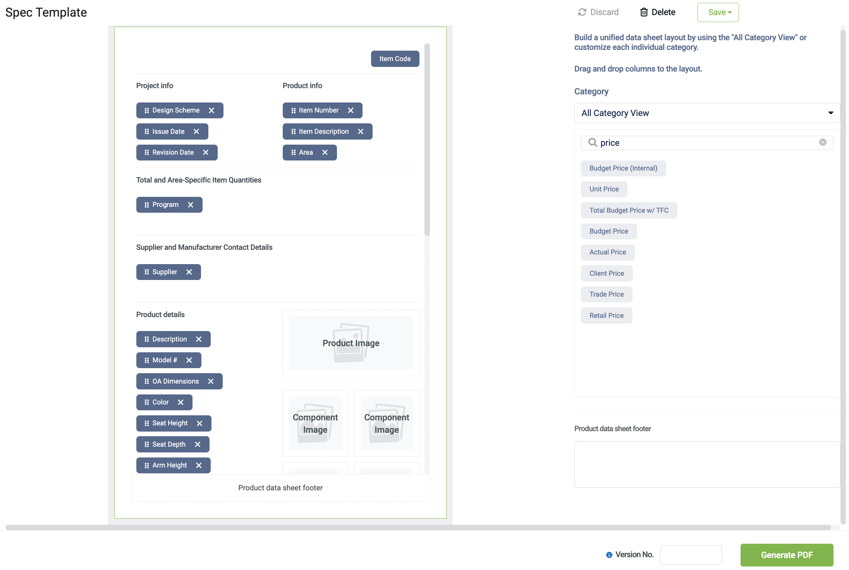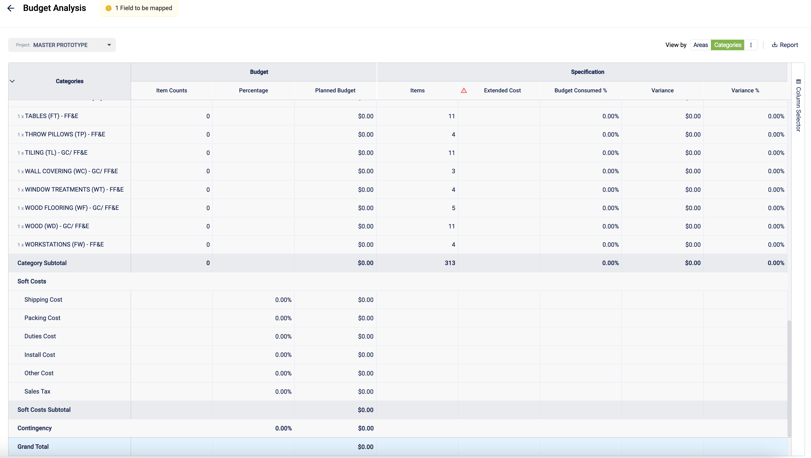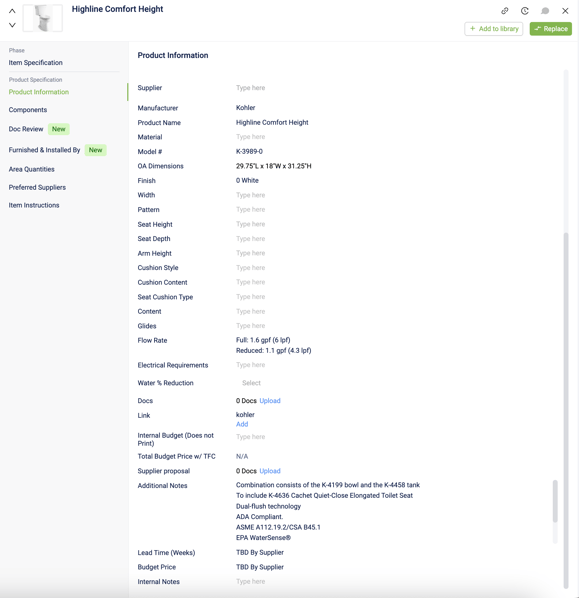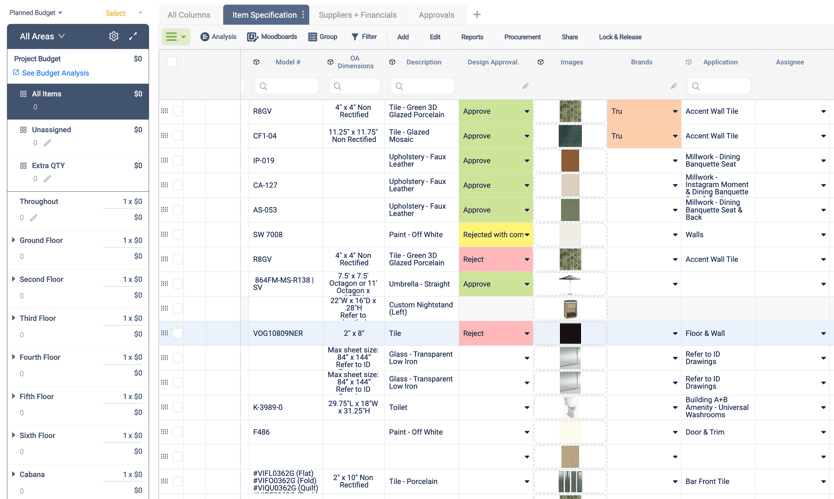Fohlio is a comprehensive specification and procurement tool that helps users take on larger projects. Empower teams to open stores faster and improve their operational workflow with specification, prototyping, estimating, and procuring tools.
Accurate budgets don’t start in accounting, they start in design.
In interiors, budgeting usually shows up late to the party. The spec book is already finished, and now someone’s trying to reverse-engineer the numbers into something that won’t get flagged by finance. Sound familiar?
But here’s the thing: every single spec—every chair, pendant, tile—carries a price, a lead time, a vendor reality. And if your team isn’t looking at those numbers during design, they’re flying blind.
For firms that manage both design and procurement in-house, this disconnect hits harder. You’ve got the power to create seamless workflows—but only if everyone’s working from the same playbook.
If specs are in one tool, procurement in another, and the budget lives in a spreadsheet that hasn’t seen daylight since last week, you’re not managing the project—you’re managing chaos.
That’s where Fohlio steps in. We connect specs directly to real-time financials, so your entire team—design, procurement, and finance—can make decisions based on the same source of truth. No bottlenecks. No guesswork. Just momentum.
Read: The Interior Design Firm’s No-Nonsense Guide to Cost Analysis & Budgeting
The Spec Book Is a Financial Document
Let’s stop pretending it’s not.
A spec isn’t just a visual decision—it’s a financial one. Every product you spec carries numbers that can make or break your project:
-
Unit cost
-
Quantities
-
Extended cost
-
Markup and margin
-
Shipping fees
-
Lead times
-
Vendor availability
Those numbers don’t live in the accounting system—they live in your specs. That makes the spec book one of the most important financial documents on the project.

Create spec books and reports that incorporate real-time financial data. Just drag and drop information blocks to build customized documents that reflect your project’s costs.
But too often, these numbers aren’t visible until someone in procurement says, "We can’t order this."
Here’s a better way: When real-time financial data is embedded into the design process, every decision carries context. You know how much that fixture costs, how long it takes to arrive, and whether it fits within your margin goals before it hits the sheet.
Take a firm that spec’d a pendant with a 4-week lead time. Procurement later flagged that it had ballooned to 14 weeks—and cost 20% more. Cue: budget panic, respec, and a timeline that slipped by two weeks. With real-time pricing and lead time visibility, that wouldn’t have been a surprise—it would’ve been a solved problem before it became one.
The takeaway: Specs aren’t just part of the design process. They’re the foundation of your budget. And they need to be treated that way.
Why Budgets Fall Apart
It’s rarely one catastrophic misstep. It’s a string of small, seemingly harmless errors:
-
Design finalizes specs using outdated cost data.
-
Procurement starts sourcing and runs into long lead times or vendor issues.
-
Finance sees the numbers and demands a rethink.
-
Designers are forced to compromise on quality, aesthetics, or both.
-
Timelines slip. Confidence drops. Tensions spike.
Now layer that across dozens of vendors and hundreds of products, and you’ve got a perfect storm. Not because anyone made a reckless decision—but because everyone was working with incomplete information.
The fix? Syncing spec, procurement, and budget data in a single platform. That’s how you catch small issues before they snowball.

Fohlio’s budget analysis tools let you dive deep into project spend. Break costs down by area or category to see exactly how your budget stacks up—so you can stay on track, every step of the way.
One commercial firm told us that after centralizing these workflows in Fohlio, they saw project delays drop 40% in just two quarters. Because when your data talks to each other, your teams don’t have to play detective.
Read: The Pain of Manual Budget Reconcillation and 6 Ways To Fix It
Connecting Specs to Real-Time Financial Data: A Game Changer
When you spec in Fohlio, you’re not just picking products. You’re making decisions with financial clarity built in.

Get a full picture of the costs tied to your specs. From actual and trade pricing to budget numbers, taxes, and extended costs—you can drill into every detail at the unit level.
Here’s what that looks like:
-
Real-time vendor pricing and availability—no surprises
-
Extended cost calculations that update as quantities shift
-
Lead times surfaced during design, not after
-
Markup and margin transparency across product categories
Now picture a weekly project review where everyone—design, procurement, and finance—is looking at one live dashboard.
Design sees visuals and finish details. Procurement knows what’s ready to order and what’s pending. Finance gets a clear read on how actuals stack up to budget targets.
No digging through email threads. No reconciling three spreadsheets. Just answers, when you need them.
Read: 5 Ways to Eliminate Time-Wasting Procurement Emails
Goodbye Handoffs. Hello Alignment.
The traditional workflow goes like this:
-
Design completes the spec book.
-
Procurement steps in, spots issues, starts a back-and-forth.
-
Design reworks specs under pressure.
-
Finance asks, “Why is this over budget?”
Every handoff introduces friction. And friction slows everything down.
With Fohlio, that cycle is replaced with transparency:
-
Design builds specs with cost and availability in view.
-
Procurement flags risks before anything’s finalized.
-
Finance monitors progress in real time.
A hospitality group we work with used to lose weeks to rework. After integrating teams with a shared dashboard, they cut spec-related rework by 60%. Another client dropped a 3-week vendor approval slog down to 48 hours.
When everyone sees the same data, no one’s left guessing.
Why Procurement Needs to See the Spec Book
If procurement’s working from a PDF, they’re working blind.
Procurement needs:
-
Clear visibility on what’s approved and what’s still in review
-
A heads-up on alternates
-
Current lead times and availability
-
Live pricing from vendors
With that information, they can:
-
Lock in pricing before it changes
-
Identify and solve sourcing risks early
-
Coordinate shipments with confidence
And that’s not just helpful—it’s mission-critical. Without that clarity, procurement becomes a bottleneck. With it, they become strategic accelerators.
Why Designers Need to See the Budget
Designers don’t want to create something that gets stripped down by finance. And finance doesn’t want to micromanage creative direction.
The solution? Visibility.
When designers can see how their choices affect budget in real time, they:
-
Stay within financial targets without sacrificing intent
-
Make smarter tradeoffs when needed
-
Propose cost-aligned alternates without compromising the lo
On the left panel, specifications are mapped directly to planned budgets. Break them down by area or cost category to see exactly where your resources are allocated—and spot overruns before they happen.
Instead of designing in a vacuum and hoping it sticks, they’re building within a framework that actually supports execution.
One lead designer told us, “Once I could see what I was up against, I started getting signoffs faster—because I wasn’t crossing any red lines I didn’t know were there.”
Shared Visibility = Shared Wins
Everyone has a different view of the same project. Design wants beauty. Procurement wants clarity. Finance wants control.
Fohlio gives each team exactly what they need:
-
Designers get spec visuals, product info, and item status
-
Procurement gets lead times, vendor info, and PO tracking
-
Finance gets budgets, markup/margin breakdowns, and total project spend
All in one place. All real time. No translation required.
One client summed it up best: “We stopped playing telephone. We started making decisions.”
Read: Custom Workflows: The Right Info to the Right People at the Right Time
What Happens When You Connect Specs to Spend
Let’s make it real. Here’s what firms see when they adopt this model:
-
Budget approvals happen faster because finance gets full context
-
Rework drops because specs and sourcing stay aligned
-
Procurement starts earlier and hits fewer walls
-
Finance runs live reports—no more scrambling at month’s end
-
Clients get accurate forecasts, and fewer change orders
You’re not just saving time. You’re building trust—internally and externally.
Want Better Projects? Start at the Spec.
Specs don’t just describe the design—they drive the budget, the timeline, and the execution.
Fohlio makes sure those specs are connected, visible, and actionable for everyone on your team.
So you can move faster. Spend smarter. And deliver better.
Fohlio is a comprehensive specification and procurement tool that helps users take on larger projects. Empower teams to open stores faster and improve their operational workflow with specification, prototyping, estimating, and procuring tools.
